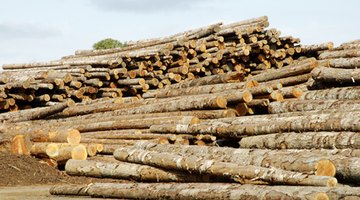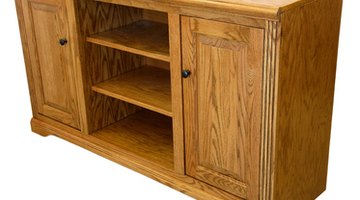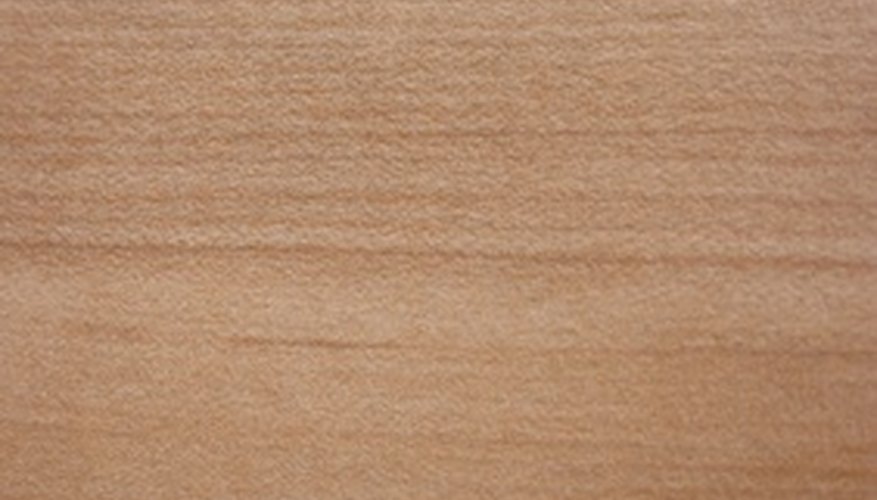Wood conditioners are liquid finishes applied to new unfinished wood before staining. While there are many companies that make wood conditioners, there are two different types: One for applying before using water-based wood stains and one for use before oil-based wood stains are applied. Cabot, Minwax, Olympic and Varathane are some manufacturers of wood conditioners.
When to Apply Conditioner
Wood conditioner allows oil-based and water-based stains to evenly cover unfinished wood surfaces. The conditioner soaks into the fibres of the wood itself, forming a protective barrier between wood cells and the colour stain to be applied. The penetration of the conditioner prevents the colour stain from blotching and discolouration.
Woods to Use Conditioner On

Softwoods have large pores and are very absorbent. Stains applied without first conditioning the wood soak in, causing blotching of the coloured stain to occur. Instead of flowing smoothly over the surface of the wood, the stain soaks in, creating dark, uneven patches of colour. Softwoods are cedar, cypress, fir, pine, redwood, Southern pine and spruce.
- Softwoods have large pores and are very absorbent.
- Stains applied without first conditioning the wood soak in, causing blotching of the coloured stain to occur.
Hardwoods

Hardwoods include birch, mahogany, maple, poplar, red oak, walnut, and white oak, and are generally resistant to shrinking and warping. They accept stains easily because their cellular structure is densely packed together. Hardwoods do not need wood conditioning before staining, but will not be harmed if a coat of conditioner is applied. If you are not sure what kind of wood you are working with, applying conditioner could save time, effort and money in the long run.
- Hardwoods include birch, mahogany, maple, poplar, red oak, walnut, and white oak, and are generally resistant to shrinking and warping.
- Hardwoods do not need wood conditioning before staining, but will not be harmed if a coat of conditioner is applied.
Applying Conditioner
Choose conditioner based on whether the end stain is oil or water based. Applying conditioner is easy, but should be done in a well-ventilated area. Working on a lightly sanded surface, clean any dust or debris off the wood. Open can and stir per manufacturer's instructions. Apply quickly using a foam brush, bristle brush or clean cloth. Allow conditioner to sit on surface for approximately two to five minutes, then wipe with a clean cloth.
- Choose conditioner based on whether the end stain is oil or water based.
- Applying conditioner is easy, but should be done in a well-ventilated area.
Applying Stain
More than one coat of conditioner may be necessary for some woods; pine from eastern, northern or western trees is softer than Southern pine. Depending upon the brand that is used, the instructions may say to wait for at least two hours before applying a stain, or to apply the stain immediately. Such contradictory information has led woodworking professionals to suggest waiting overnight before applying stain.
Making Wood Conditioner
An alternative to buying pre-mixed wood conditioner is to make it yourself. Homemade conditioner, a washcoat, is made by mixing two parts of the final varnish or stain with eight parts of white spirit. You can use an oil-based washcoat under either oil-based or water-based stains. When using washcoat, test on a piece of scrap wood before doing the final project. Lightly sand the surface after the washcoat has dried; remove wood dust and stain.
- An alternative to buying pre-mixed wood conditioner is to make it yourself.
- Homemade conditioner, a washcoat, is made by mixing two parts of the final varnish or stain with eight parts of white spirit.
Considerations when Conditioning Wood
Keep wood conditioners and stains away from open flames or heat sources. In addition to being flammable, these liquids are poisonous and should be kept away from children and pets. Rags used for applying conditioner should be tossed into a bucket of water immediately after use and transferred to trash on pickup day. Avoid getting conditioner on your skin or clothing. Follow manufacturer's instructions for cleaning brushes. Throw cat litter or sand onto spilt wood conditioner and sweep up after it has been absorbed.
- Keep wood conditioners and stains away from open flames or heat sources.
- Throw cat litter or sand onto spilt wood conditioner and sweep up after it has been absorbed.
